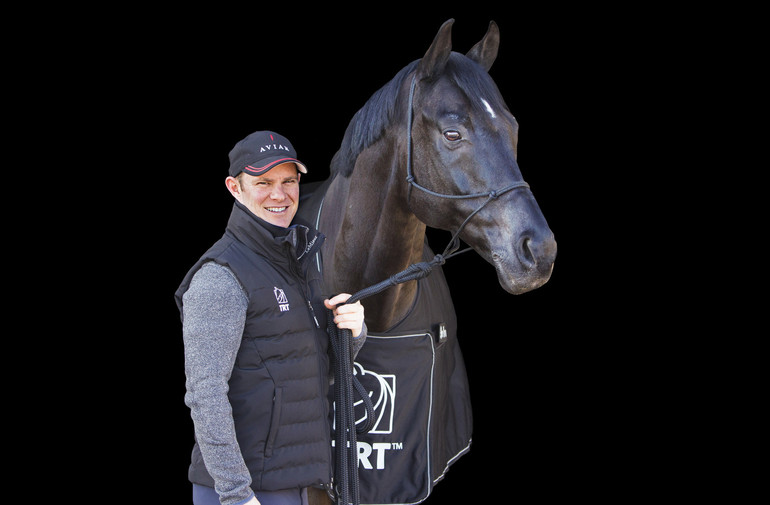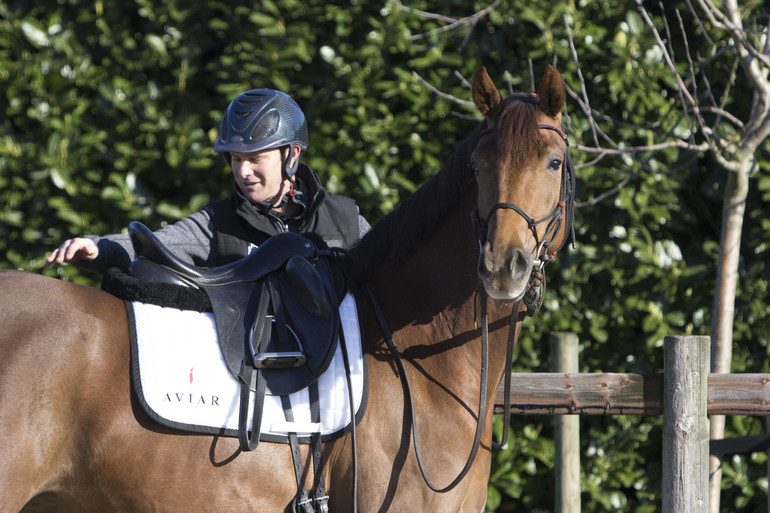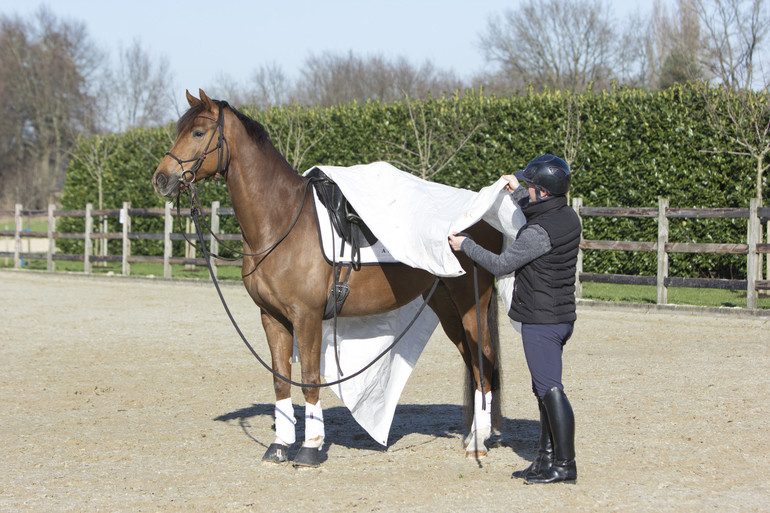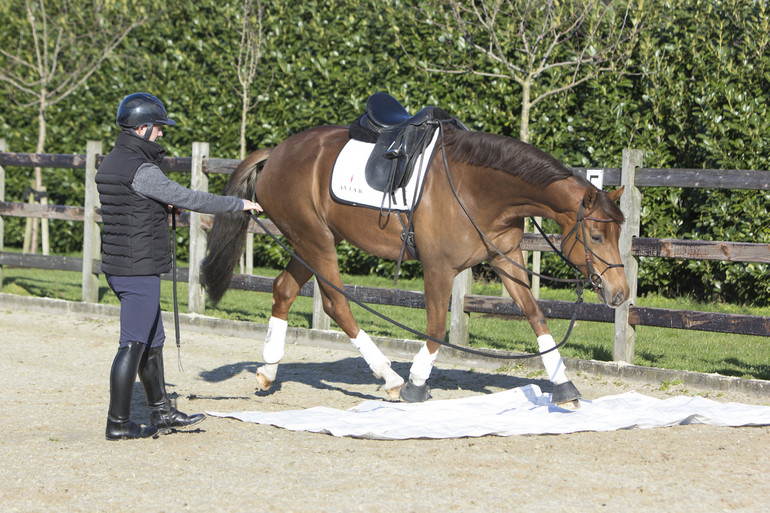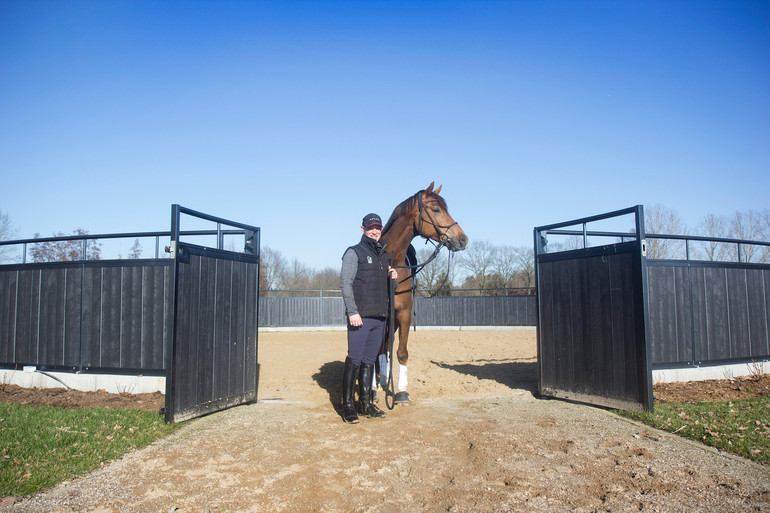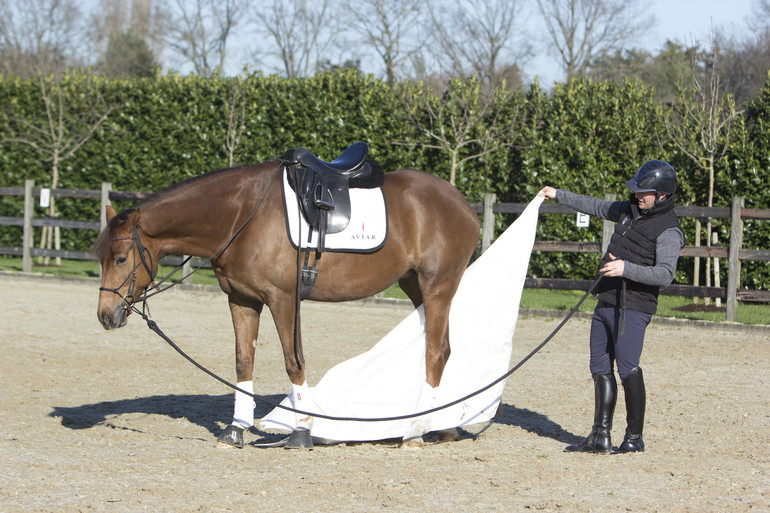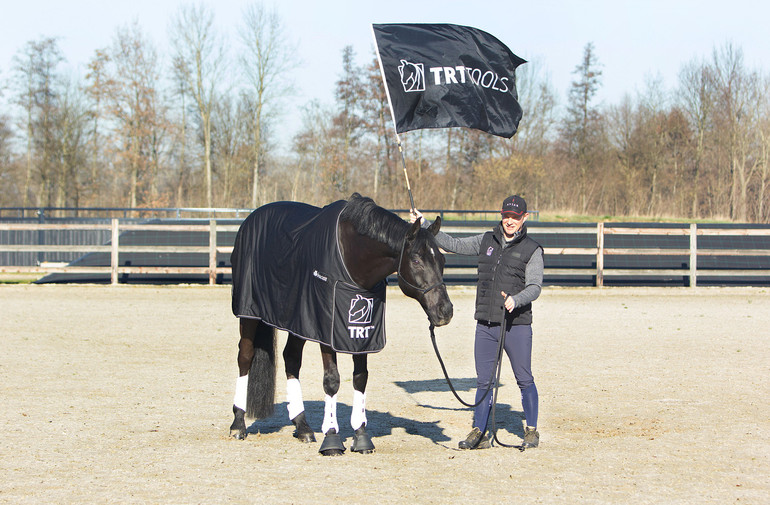Text © World of Showjumping
“A horse is the greatest gift in becoming the best person you can be, because horses hold you accountable; you have to earn their trust, the connection, the relationship,” Tristan Tucker tells World of Showjumping.
Tristan is the founder of TRTmethod, a training philosophy for horses to help them with issues created by insecurity. “My focus is a little different than most trainers; I'm not teaching people how to control their horses but teaching people how to teach their horses to be in control of themselves. When you teach horses to understand how to control themselves, they learn how to control all situations. I give horses the skills to manage themselves in the environments we put them in as sport horses.”
Not many humans are asking themselves ‘who is my horse’ and ‘what is he thinking’
“As humans, we are constantly distracted from the present,” Tristan continues. “Especially in equestrian sports, because we are constantly looking at what the task is and every human that is around us is talking about different goals. Not many humans are asking themselves ‘who is my horse’ and ‘what is he thinking’, ‘how is he able to manage this situation?’. These kinds of conversations are rare. However, if you want to understand your horse better, these are the questions you should be asking. You will be better for it and all the other aspects are going to fall to place. If we don’t think about these things, then the downfall of our horses will be at our peril.”
“The flight instinct of horses, their natural instinct of protection, only kicks in when they are in a situation where their knowledge runs out. Therefore, it is important that we are not putting our horses in situations where all they are left with is their natural instinct to survive,” Tristan says. “The more information we can give them that helps them to thrive, the better. Horses that are well educated will be more comfortable, perform easier and this way the reflection of horse sport is going to be more positive as well. Fail videos and situations where things go wrong are a reflection of a lack of information.”
Working with his natural feel
Originally from Australia, Tristan was brought up in an equine environment. “My mother was working with race horses and I went through a normal pony club system and got influenced by many different disciplines,” he tells about his background. “Through that I started to work with horses, without having any specific skills or knowledge but relying on my own feel of getting around the horses and not offending them. I started to help people with horses they were having difficulty with, and went along learning new and different techniques from lots of different people. No matter what their discipline, I have been open to learn from anybody that could do something good with horses. I then started to put together those aspects and when I first came to Europe, I got some very good mentors who also opened my mind to the possibilities of what you can teach a horse.”
I got horses with a variety of problems, the worst of the worst and of course those horses are the ones that teach you the most
After initially visiting Europe, Tristan returned to Australia, where he had a large business. “I started hundreds of horses a year and worked a lot with race horses as well as jumpers, eventers and dressage horses,” he tells. “I learned a lot from the horses, especially from the extreme cases.”
Tristan returned to Europe in 2008 and is now based in the Netherlands. “In the beginning here in Europe, I did go through the phase of becoming that guy people would refer to as kind of a Harry Potter, and it took a while to get people to understand what I do. I got horses with a variety of problems, the worst of the worst and of course those horses are the ones that teach you the most. When you have to do a kind of rehabilitation, you learn what causes the problems and what information the horses need to resolve their issues.”
The horse is not the problem
However, to say that a horse has a problem or an issue is actually not correct – the problem never sits with the horse, Tristan points out. “An issue is only a reflection of the human perspective of said “problem”,” he explains. “It is all about your mindset. For example, finding a horse difficult to get on because it does not stand still can be an issue for someone – and the narrative in that human’s mind is that the fact that the horse does not stand still is a disaster. Now give that horse to another rider, a different type of person, who just jumps on while the horse moves and does not even have awareness of whether the horse was standing still or not; the narrative in this human’s mind is totally different while the horse stays the same. However, then the horse is already in first gear when this person jumps on and they get going, the circulation of energy in the horse’s body is already at high speed, another horse approaches them and this horse spooks – and then it all of the sudden is a horse that is horse-shy in the warm-up. Another “problem”! Then give this horse to Sally down the road who only hacks out in the forest and climbs on as the horse is eating. There are no other horses to spook at, so Sally thinks the horse is perfect and they never have any problems – even though she has far less skill than the previous riders. So, a problem is only our human reflection, our mindset, where we think the problems are – the problems do not sit in the horse.”
A problem is only our human reflection, our mindset, where we think the problems are – the problems do not sit in the horse
“The problem is with our perspective of what we want to do with our horses, and the fact that when we name something a problem, it becomes such in our mind,” Tristan continues. “I think of a horse’s ability to learn things as an opportunity; a horse not knowing a piece of information needed for him to relax and perform in a certain situation only creates an opportunity for me to teach him. And if I don’t know how to teach him, that horse is now my gift of pushing me to learn something new. It is about self-knowledge and self-improvement through the reflection of our horses. And when you have horses for that purpose, for self-reflection and self-knowledge, then getting a horse that is having some undesired behaviour is an opportunity, not a problem. It is the human factor of not wanting something to happen, without effort, that labels anything to be a problem. It is easier to say the horse is the problem, because I want this to happen, and this horse is not doing it the way I want. But if you are not able to teach your horse, is it the fault of the horse or the human? That is where the constant reflection has to come from.”
Training techniques and knowledge can’t keep up with breeding
The level of sensitivity in all horses across all disciplines is getting higher and higher due to the changed demands of the sport today, while the skills people have to handle these horses are not improving at the same speed, Tristan points out about the root-cause of most issues he encounters. “What we are trying to breed now are horses that are electric, more powerful, more athletic, and with those extremes comes a high level of natural instinct. The horses from 20 years ago that you could lunge and then put the whole family on, they no longer exist. These days, you can lunge a horse for three months and it is still going to throw you off,” he says.
Horses’ previous memories, experiences and emotions from certain events can dictate the patterns and paths in which they are going to travel in the future
“The biggest problem I see is that from the beginning, people do not realize how much influence they have on their horses,” Tristan continues. “Horses’ previous memories, experiences and emotions from certain events can dictate the patterns and paths in which they are going to travel in the future. And then there is the misinformation we are giving the horses: From a foal, what they experience in a typical European free stable, is a lack of education in how to interact with humans and how to manage themselves in all the situations they are going to experience in the future. We could get away with it 20 years ago but we can’t now, and that leads to many undesired behaviours. A fearful horse, a horse being shy of other horses, not standing still while the rider is getting on, a dressage horse being spooky in the ring, a jumping horse being afraid of the water – all these kind of issues have everything to do with the type of horses we are breeding and the fact that the training techniques and our knowledge are not growing at the speed in which the breeding is changing.”
Ignorance is bliss
Safety is a huge issue in equestrian sports, and sensitive horses in hands of people that are not capable of handling them can create dangerous situations. “We see it across the board; from the beginners to hobby riders down the road to the top sport,” Tristan says.
“Sometimes ignorance is bliss; you don’t know what you are doing wrong until something happens,” Tristan says. “But for sure it is becoming more of an issue because the horses are more sensitive and more susceptible to using their flight instinct to protect themselves. These days, if you go to the vet check at a large international competition, it is like a circus compared to 20 years ago. Horses are jumping and flying around, kicking around and bucking on the end of lunge ropes and some of these people don’t seem to be able to even lead their horses – and yet they are there to ride at Grand Prix level.”
Sometimes ignorance is bliss; you don’t know what you are doing wrong until something happens
“There should be a natural progression in education,” Tristan continues. “Horses have to first understand themselves before they can understand any task we ask of them and the biggest thing is that they have to understand the environment in which they are. Often, you see riders only focused on the training part – for jumping horses, the jumping. Riders are making sure their horses are rideable, that they are fit to jump clear, but how many times a week do they train their horses to be comfortable in the environment in which they have to perform in the end? We spend all this time on the technical aspects but do not focus on the horses being able to manage themselves in the place in which we are going to compete in. That part of the education is as important; you have to give your horse all the information it needs for the exam. You have to view it as an exam – and if horses step into the exam without the right amount of knowledge, then they are going to be forced to fail. A failure for the horse is sometimes not recognizable by the human; a horse can maybe even jump clear but have been terrified and pushed to their physical limits of capability and therefore he is in a state of suffering afterwards, while from our perspective the goal is achieved, we jumped clear. However, the how a horse is doing what he is doing is just as important as the fact that he is doing it. Having a horse that is healthy with longevity, being able to enjoy the sport for a long period, is the aspect which we need to pay most attention to.”
It all starts with awareness
When Tristan starts working with a new horse, he strips off all equipment and begins from the ground. “Depending on the case, I start them free or in a rope halter. The first thing is the horse’s awareness: I start to observe if he understands where he is within this space and in relation to us. Many horses tend to be lost in space due to their natural flight triggering instinct which revolves in them all the time. They are externally distracted by everything and they don’t have a good awareness of themselves or what their bodies are doing. Giving them this reference in the beginning also gives you value as a human; the horse starts to see you as someone who gives them sound advice. This aspect of awareness in the beginning is very important, because when you have value and the horse can see that you can give them information that is going to help them feel better in a certain situation, then the learning process becomes very rapid.”
When horses have a good connection to their physiology and they understand the dialogue and the connection in their body, then they are much better equipped
“Self-awareness is also the first step of the horse learning that he can be in control of himself and he then no longer has the feeling that he is being controlled,” Tristan continues. “That is the beginning of the horse feeling like he can self-soothe and self-manage. From there, you are able to start to feel where their weaknesses are; what they are good at and what not and what is their operating system for the 23 hours that they are not with their human. You can see the pattern and order of movement, if they have a good communication and a dialogue in their body. Just like for humans, the connection to their own physiology is essential for horses to allow them to control themselves in situations that are going to be challenging. When horses have a good connection to their physiology and they understand the dialogue and the connection in their body, then they are much better equipped. They will be more balanced and therefore more confident, and their output as sport horses increases as well.”
Our responsibility
For Tristan, the relationship between horses and humans is very much about the awareness of each other. “It starts there,” he says. “If the horse has no awareness of the human, there is no connection and vice versa. Who is my horse and what is he thinking? If you cannot answer these questions, you end up operating on something that you want; something you want out of the horse, something you want to do with him.”
“The awareness of each other is very important and for me the relationship with a horse is about being their mentor,” Tristan points out. “It should not be about being a mummy and soothing your horse and reassuring him, because there are going to be situations in your horse’s life where the challenge of the environment is going to outweigh the reassurance. And when we cannot reassure them, the horse gets into a panic and a frightened state. And a dictatorship – a person that is trying to tell the horse what to do and make the horse do what he wants – is of course clearly a suppression and a horse cannot thrive in that environment. If you operate in this way, you will end up in situations where horses are not going to be ok physically, they end up injured or mentally don’t want to do the job – so you are only going to create frustration on both sides. Therefore, the mentor type of relationship is for me the one that works best. With this approach, you are teaching horses the most about themselves and giving them the skills to thrive in the human environment. It is our responsibility to teach horses what they need to know in order to thrive in this world. Not only exist, live or survive but really thrive and grow, and feel that they want to do the job more than the human.”
With the right trainer and the right rider who has the right knowledge, horses can receive self-knowledge
“Some people think horses should run in the field and that nature is the kindest place,” Tristan says about the wide spectrum of humans involved in equestrian sports. “However, thinking that nature is kind is a misconception. Nature is not kind. A natural environment for a horse in the wild is purely about survival, it is not about growth or having a feeling of personal development and self-knowledge. And then you have people at the other end of the spectrum, purely trying to achieve something for themselves at the cost of the horse. To these people, a horse is a vehicle for their own personal success. Their moral boundaries and ethics, those lines are often very blurred for this group of people. And then you got all the variations in between, but what is most important for both aspects of the spectrum, from both ends, for different reasons, is that horses cannot achieve the same gift in life in nature as they can with humans. With the right trainer and the right rider who has the right knowledge, horses can receive self-knowledge. What horses can achieve from being with humans is this feeling of growth and development – it is the difference between someone just existing on the couch, doing nothing versus someone that is going to develop themselves mentally, physically and emotionally to the best of their ability. With the focus on the possibility of growth, there is richness for both horse and human. We have seen this throughout history; there are so many moments of triumph that horses and humans have shared. What we can receive in life together is far greater than what we can do apart.”
Not about what we do but why we do it
With Tristan’s view of the relationship between horses and humans and his work on improving it, we cannot help but ask him how he feels about the current discussion about equestrian sports’ social license to operate. “What is very important about the social license is that we are focused on the human aspect; what humans think of equestrian sports,” Tristan begins. “And what humans think of it is a reflection of us. For this reason, we have in the past invented phrases like ‘a happy athlete’; because we are trying to tell the world that a happy athlete is what we are creating. However, this is just a phrase created by humans to tell other humans that what they are doing is ok. Actually, all this does is show that you as a human don’t want to be held accountable. Phrases like that lead to avoiding self-awareness, while people instead should constantly question their ethical and moral boundaries, look at what they are doing, how they are doing it and most importantly, why they are doing what they are doing. In the end, it is not about what we do but why we do it. What is going to give us a very clear line in this is looking at what the single most important thing to a horse is. Often, people are confused; they do what is popular, they say what they think is the right thing to say. Instead of saying something that makes you feel like what you are doing is ok, you have to make an individual assessment of yourself.”
If we keep creating guidelines based on what humans think is a good thing to tell other humans, then we are completely lost
“Knowing what is the single most important thing to your horse – what is his individual character, where do his insecurities lie, what is the perspective of the horse in all the situations you put him in? This is where we need to create guidelines. If we keep creating guidelines based on what humans think is a good thing to tell other humans, then we are completely lost. It has to come from the horses’ perspective. And what is the single most important thing to a horse? In any room, in any discipline, at the highest level, more than 98% of the people cannot answer this, and that is scary. In a big room with professional trainers, riders, vets, heads of federations, heads of organizations, most of them come up with phrases that were created by humans, such as ‘horses have to have time in the field’, ‘horses need social contact’. Basically, that is just saying that horses have to have these things that we have decided they need and if they have them, they are happy. That is a mass generalization. We need to know not only what is essential to a horse in general but how is that then specifically to my own individual horse?”
It has to come from the horses’ perspective
“The single most important thing for a horse is survival,” Tristan says. “It is the single most important thing to any living organism, plant or animal. Ensuring survival means collection of knowledge and the goal of collecting knowledge is limiting uncertainty. Being uncertain, unsure in a situation, means a risk for your survival and then you are thrown into a fight-or-flight-reaction. So, a horse in nature is only ever in this fright-or-flight space, because he is never in an environment where he is given rules and knowledge and education about how to manage himself. The elements of sound and movement are threats to a horse in nature. When horses are with humans, we can teach them what these elements are and what they can do with their physiology when they experience these elements. This way they will be in control of the situation and no longer feel like they have to protect themselves by fleeing. The difference between nature and human environment is survival and the ability to thrive.”
“The other aspect of social license is the environmental impact of our industry,” Tristan continues. “It is not only the treatment of the horses, but how does the industry, horses and horse people, impact the rest of the world? The carbon footprint that is created by one horse on top international level, flying around the world, is quite big. And the large international competitions, where we are watering huge stadiums while the farmers in the area are not allowed to water their fields… What is the reflection of our sport and the reflection of horse people within the community in this society we are operating in? The most important thing about creating an intelligent social license is to be united and in the horse world, we are not united. We are a jumping rider or a dressage rider, and each believes to be better than the other. However, the general public sees us all as equestrians and therefore we have to act together and be united, so that our industry becomes strong as a whole. In history, a movement was created by being united, spreading positivity and motivation, but at the moment we are segregated in horse world. We are suppressing criticism and we are creating negativity by pointing out all the things that are not good. All the activists are only focusing on the negatives, maybe not realizing that if their genuine concern is to make the sport better, they are not going to do that with constant negativity. Constant negativity only creates suppression and segregation within the community."
Chasing a feeling
“Like all humans, I can say that I like helping horses and I like helping humans, but of course I do it for myself,” Tristan explains about his motivation in doing what he does. “I do it because I feel my own personal development and growth; horses are a reflection of myself. I get small rewards seeing a horse learning something it couldn’t do before, seeing a horse grow and become better, not fearful but successful. In life, we are always chasing a certain feeling, and horses give me a sense of self-knowledge and self-improvement. The more I can dive deeper into that, the more fulfilled I feel with the possibility of growth. A human without growth is deflated and not progressing. For me, my work is about that improvement, which is an eternal goal that is never meant to be met; there is no end-date for my life with horses. Ten lifetimes will not be enough to learn, the growth is infinite. And that excites me, so it all comes back to chasing a feeling.”
Any exchange with horses is based on something very pure; it is not polluted by someone’s need or greed
“A horse never lies,” Tristan concludes. “They never waver from what is their basic feeling of existence; there is no confusion in that, and therefore, we are able to get a direct reflection of ourselves through them. If you ruin their trust, the next time you come back, they don’t think ‘oh I need the money, I need to get this job done, I’ll just forget about it’ – no, if you have done wrong by a horse, they will hold you accountable. A horse is the greatest gift in becoming the best person you can be, because horses hold you accountable; you have to earn their trust, the connection, the relationship. Any exchange with horses is based on something very pure; it is not polluted by someone’s need or greed. For me, being able to exist in that space, on a daily basis, is giving pure essence of life.”
14.9.2023 No reproduction of any of the content in this article will be accepted without a written permission, all rights reserved © World of Showjumping.com. If copyright violations occur, a penalty fee will apply.



